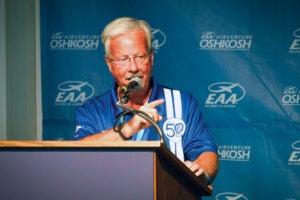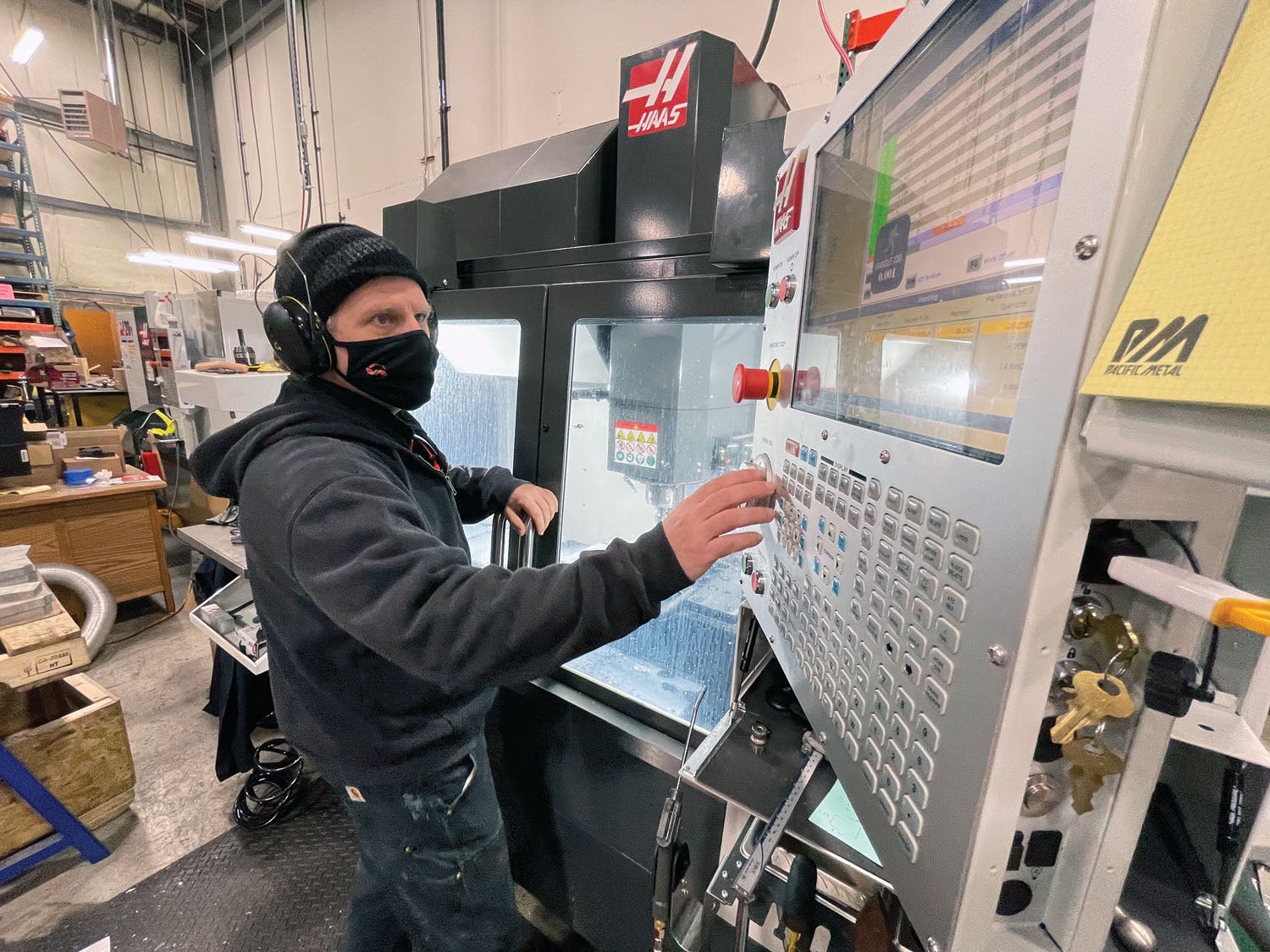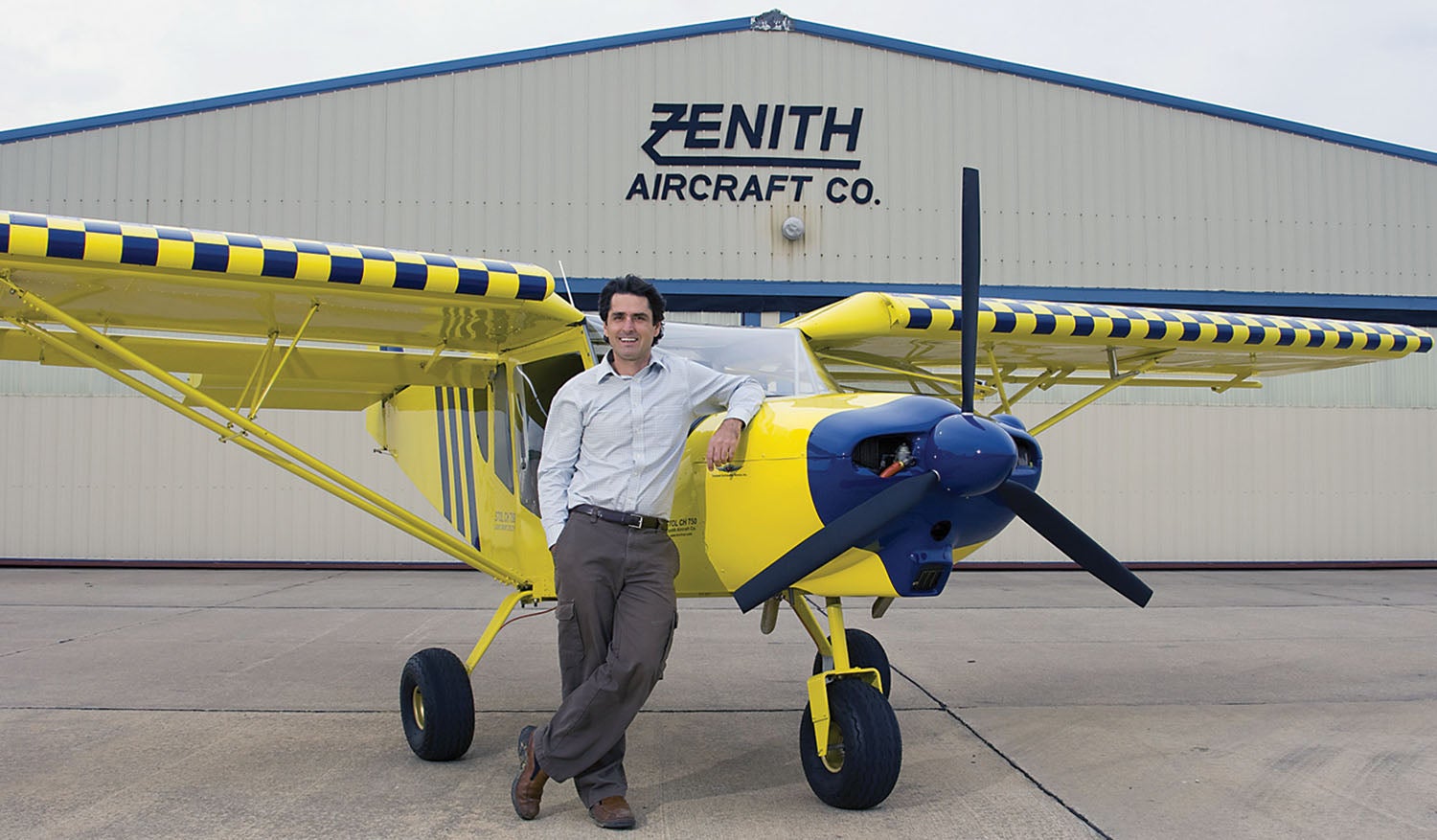 For the general public, the idea of constructing your own airplane, with your own hands, in your own space, is borderline fantastical. To them, it seems crazy that you can do it at all, and would seem even crazier if they understood that we’ve been doing just that fantastical thing for almost seven decades. (Indeed, as this is written, EAA has just celebrated its 68th year as an organization.) And crazier still to know that “homebuilt” aircraft–a shorthand we use to describe Experimental/Amateur-Built aircraft—number almost 10% of the light-aircraft fleet.
For the general public, the idea of constructing your own airplane, with your own hands, in your own space, is borderline fantastical. To them, it seems crazy that you can do it at all, and would seem even crazier if they understood that we’ve been doing just that fantastical thing for almost seven decades. (Indeed, as this is written, EAA has just celebrated its 68th year as an organization.) And crazier still to know that “homebuilt” aircraft–a shorthand we use to describe Experimental/Amateur-Built aircraft—number almost 10% of the light-aircraft fleet.
This much you, as a KITPLANES® reader, already know. What we’re interested in here is not as much where we’ve been as where we’re going. So we put together a series of features with a broad intention of asking: What’s in our future? What will homebuilding look like in 10 or 25 years? We’ll approach this in four parts. First to talk to those in the industry for their big-picture perspective and outlook. Then we’ll take a closer look at engines (almost always the literal drivers of invention in our world), followed by avionics and then to consider the future from the builder’s perspective. Enjoy!
What the Makers Say
It’s one thing for us to sit here and prognosticate about the future of homebuilt aircraft. But we build magazines, create videos and write web stories. And while that brings broad perspective, it’s not like we have to create a business plan around the Next Big Thing. (Thank goodness!)
It doesn’t mean we’re not curious. So I set about talking to a handful of the stakeholders in our world, including EAA CEO Jack Pelton in addition to a group representing Van’s Aircraft that included founder Richard VanGrunsven as well as marketing head Greg Hughes and chief engineer Rian Johnson. I also spoke with Kitfox’s John McBean and Zenith’s Sebastien Heintz specifically for this story, but there’s also quite a bit of subject synthesis based on regular conversations I have with others in the industry. I’m always interested in knowing where we’re going, and that line of questioning has become common in conversations I have with our industry colleagues even if that’s not the main topic. (Sometimes it’s just complaining about UPS.)
Key Contributions
In a very broad sense, where homebuilding goes in the next decade or quarter century hinges on several interlocking issues. First is economic. What will our world look like in the near-ish future for those who can afford to build and maintain aircraft? If I knew the answer to that, I wouldn’t be in publishing, but the indicators are better now than they were in 2007 and into 2008, when the bottom fell out of many industries, including our own.
The other issue is the age of the pilot/builder population. It’s no secret the average is going up, and so the big question is: Can we entice enough new, young participants to keep our world going in 2031 or 2046?
Then, of course, are the influences of the current regulations and the possibility of changes in the future. Homebuilding has been remarkably stable over the last 20 to 30 years, with the more recent addition of Light Sport Aircraft and the Sport Pilot certificate adding aircraft and pilots in a marginal fashion rather than usher in exponential growth. (When we started covering LSA at the beginning, some pundits were calling for thousands of new LSAs a year pouring into airports across the land. Didn’t happen.)
Industry Voices

It’s fair to say Jack Pelton has been around. He’s perhaps best known from his stint as CEO of Cessna, but he was at Dornier and Douglas Aircraft in Long Beach, California, before that. (Small world department: In the 1990s, while I was building my Pulsar, I could probably see Jack’s office window in the Douglas building.) As EAA’s CEO, he not only oversees the juggernaut that is AirVenture, but has his hands in guiding the association as homebuilding and so-called sport aviation (non-homebuilt, recreational flying) changes over time.
“I have a feeling that in the next 10 or 15 years, things will start accelerating in terms of innovation, compared to what we’ve seen in the last 10,” he said. “I really say that because of the UAS [unmanned aerial systems] sitting over on the side. I think there are elements of these designs that will become directly applicable to the homebuilt market in a relatively quick period of time.” In particular, Pelton calls out the electric powerplant piece of the puzzle, “which we have to figure out how to certify,” he says. Of that segment, “What will mature is the technology that becomes available, reliable and capable,” he says. Here, Pelton is among the many watching other industries that have electric propulsion as the main driver for cues. Aviation, even UAS in the realm of so called “urban mobility,” simply doesn’t have the market footprint to finance battery, controller and electric-motor development at the pace that’s needed. But cars, computers and portable devices do.
“I am excited about what’s going to happen on the flight-control side,” Pelton said, still on the UAS topic. “If you look at the commercialization of that technology, we might be having fly-by-wire homebuilts before long. I think these will become so robust and easy to incorporate into an airplane,” he says. “I’m really impressed with what the companies are doing with all these multi-rotor UASs, but we don’t need all of that technology. We just need a little. And it could be cheap and off-the-shelf, in my mind.” For that matter, Pelton thinks that what we’re seeing in Garmin’s Autoland technology (now just in high-end turbines) could trickle down into homebuilts eventually, offering safety benefits like envelope protection and synthetic stability. (See Larry Anglisano’s upcoming piece on the future of avionics.)
Circling back to the kit industry of today, Pelton remains impressed with the state of the art. “When you look at kit manufacturing today, these companies have really leaned things out,” making the task much easier for the builder than it has been. “If you leaned it out much more, it wouldn’t be fun; you wouldn’t have enough to build,” he says.
A MOSAIC Painting
Legal issues will, as always, shape the Experimental landscape. One of EAA’s long-term issues is a program called MOSAIC, which dates back to 2013. In short, MOSAIC was designed to address a number of issues in our world, from finding ways to expand on or replace the so-called “major portion” rule to figuring out how to make Experimentals eligible for limited commercial uses, like flight instruction. “Most of the amateur-built fleet are proven, safe types with a history of safe operations,” the EAA has said with respect to MOSAIC. “With the evolution of the various homebuilding industries and the falling GA accident rate, there is no longer a reason for these limitations on homebuilt aircraft.”
Pelton says MOSAIC is still on track, likely to be implemented in early 2023, despite the FAA coming under intense scrutiny over the Boeing 737 MAX debacle. “The FAA continued to work even during the 737 MAX issues, and it looks like changes in the rules around LSA will be performance based. Not specific to weight,” Pelton says. “A Warrior and 172 would qualify to be operated by a Sport Pilot. The next step up is to use certain aircraft to be used for training and other commercial uses.” He also says that MOSAIC still contains ideas surrounding additional, legal builder assistance beyond what would be considered appropriate today. “That is a safety net for people to build airplanes,” Pelton says, indicating that rather than fall back on stringent certification rules—that even the supposedly simplified FAR Part 23 versions remain complex and expensive—they will be “community-based standards.”
An example of this would be an expansion of the E-LSA concept. Right now, if you build an Experimental/Light Sport Aircraft exactly to the manufacturer’s rules and license it as such, it is subject to a much shorter Phase I flight test period (typically 5 hours) and subsequent owners can attend modest training courses to receive a repairman certificate for that airplane, alleviating one current shortcoming of the Experimental/Amateur-Built rules for non-builder owners. An E-LSA can also be modified after the initial licensing, and that confers many of the benefits of a more conventional homebuilt in terms of builder choice.
Beyond LSA
Van’s Aircraft VP and chief engineer, Rian Johnson, sets his sights further downrange, advocating for something called LPA, or Light Personal Airplane. Think of it as a category for larger-than-LSA aircraft that could be built much like an E-LSA or produced complete like today’s S-LSAs, using consensus standards in place of Part 23 certification rules.“This category is a chance to revolutionize the kit industry,” says Johnson.
Think of LPA as a larger, more capable E-LSA built in the same way—each new airplane would have to conform to the factory’s but, as recompense, you could build it in much less time than a conventional “51%” aircraft, plus fly a shorter Phase I flight test. And, like E-LSA, you could still make changes and update the equipment—deviating from the factory configuration is currently allowed in E-LSA once the airworthiness certificate is approved. “We could define a set of simple, inexpensive instruments for Phase I and that would allow builders to drop in their own avionics right afterward,” says Johnson. The LPA concept would open the door for a much more complete factory build of the kits, and help eliminate “systems- and powerplant-related errors in the first few hours of flight,” Johnson notes. As much as old-time homebuilders would feel hemmed in by this idea—we’re here to experiment!—it would almost surely be a boon for safety and completion rates overall.

LPA is one possibility going forward, but Johnson feels that absent this breakthrough, the industry should divorce LSA from the Sport Pilot rules.“We need to consider the airplanes and the pilots separately,” says Johnson. His contention is that we could build an expanded LSA-like program that stretches beyond the current Sport Pilot limitations, and give those pilots a path to flying these newer designs via appropriate training and endorsements.
Van’s community director, Greg Hughes, follows that line of thinking. “Let’s not arbitrarily limit LPA” or next-generation LSA “by something like horsepower. Instead let’s certify airplanes under a standard for safe airplane design and building, and then completely separately certify pilots using an expanded training and endorsements mode,” says Hughes. Right now, there are processes in place to let pilots trained in Cessna 172s move up to high-performance and retractable-gear aircraft, so why shouldn’t this concept also apply to something that looks like Sport Pilot?

Both men feel that these changes would bolster the market, make for better homebuilt aircraft and increase completions, which are already quite good for the RV series. “I imagine we have much higher completions than ever,” says Van’s founder Richard VanGrunsven. “People are a lot better grounded now. Even in the 1980s and ’90s, it was kind of the Wild West. People had a bunch of new stuff at every airshow that would not be there the next year. The buying public is not climbing aboard the wild promises the way they used to. They’re looking at the track record.” And these more mature products, from more mature companies, are more likely to be completed.

Not only are customers a lot more savvy, they expect more from the companies themselves. “Since the industry began turning to more highly automated manufacturing,” says Hughes, “we’ve been able to produce kit components to a higher standard and to go along with that we’ve continuously improved our plans, drawings and instructions.” Which is true for Van’s as well as for most of the leading companies, and the upshot in the near term is that we can expect a continuation of these developments.

Better kits benefit the companies as well as the builders. “When we have a more easily built airplane,” says Sebastien Heintz, Zenith’s president, “we have fewer questions from builders and that’s easier on our support staff. Even though we have far more kits in the field now than we had 10 or 20 years ago, our support staff is about the same size. Part of that is to realize that our parts and our instructions and all the other things we do for training, like our builder events, help make completions possible.”
Chiming in on possible rules changes, Heintz believes that the current “51%” rule works just fine and there’s no reason to change it. “It’s well understood and gives us a lot of freedom to choose,” he says, pointing to his company’s support of alternative engines, among other things.

Market Segments
If you look back over the history of homebuilts, it’s easy to identify generational trends, from early efforts that were in fact quite similar to the certified designs of the day, through a period of great innovation (thank you, Burt Rutan) that embraced unusual configurations and materials, right through the “speed wars” of otherwise conventional (but highly powerful) composite homebuilts in the 1980s and ’90s. Today, STOL is king, backcountry flying is the flavor of the month—or year, or maybe decade?

Kitfox’s John McBean is, perhaps understandably, bullish on the backcountry airplane category. “It’s hot now and I think it’ll stay that way,” he says. “Pilots are realizing they don’t need a lot of speed,” he says, because most in our world are using their airplanes for recreation. “They want to be able to have a lot of utility and that means good STOL performance.” It’s for those reasons he thinks backcountry flying will endure. “Actually, it’s always been there,” he says, “a little bit of a secret for some time. But I can see the desire to go fly for 30 minutes and be in a place without cell service.”
A big challenge, McBean feels, centers on training. “We have to keep up with training, especially where pilots are going into unimproved strips,” he says. Perhaps typical of some manufacturers, Kitfox’s owner McBean is watching the market carefully but not intending to make big swings in the product set. “Already we’re taking orders through the fourth quarter of 2022,” he said in early 2021.

One Look Back at Regulations
While EAA’s Jack Pelton sees changes coming for the rules that govern homebuilding, not everyone feels they need to change. “I don’t think we need to change the basic rules,” says Sebastien Heintz. “It’s a system that works now, and we understand it.” Kitfox’s John McBean feels the same way. “I say we maintain the 51% Rule we have. We need to stop [messing] with the airplanes and figure out the medical issue. I’d eliminate medicals for private pilots, and I’d work on making training more available. That’s a big driver for us. If we can improve the accident rate and, I think, get some new players into the insurance game, we will have a bright future.”
Final Look Ahead
What emerges from these discussions? The shorter-term trends are likely to continue, with homebuilts slowly gaining in overall market share, with the kit designs gradually evolving to be ever easier to build (and build at a higher level). Advances in manufacturing techniques will push the boundaries of the “51% Rule” and cause kit makers to negotiate advances that improve a builder’s life without running afoul of the FAA. It’ll be a delicate dance, for sure.
Longer range? We have been on the cusp of big changes for a long, long time: the change in propulsion technologies, changes in the rules that surround our sport, changes in the electronic technologies employed. Few things move quickly in aviation, though, and the general consensus is that Experimental/Amateur-Built aircraft will look much the same for the next few years. Even if the most generous elements of MOSAIC go through, it’ll be half a decade before the industry can respond with super-quickbuild kits or E-LPA designs you might be assembling at home. There’s always the possibility of a seismic change, an inflection point that makes, say, a UAV-like technology too compelling to ignore. But don’t be surprised if, say, the 2031 RV-21 is a mostly metal tractor monoplane that you still have to put together.
Photos: Jon Bliss, Richard VanderMeulen, Paul Dye, Shutterstock and courtesy of the manufacturers.














I read several of the articles with interest as to where the home built trends are leading. I have been working on a Zenith 701 with a half dozen other retired folks attached to EAA chapter 237 in Blaine Minnesota.